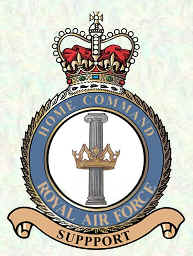| RAF group | dates active | notes |
|---|
| No. 61 Group RAF | 1940
1946–1959 | No. 61 Group was first formed on 1 July 1940 in Northern Ireland, and was raised to command status and renamed RAF in Northern Ireland on 1 August 1940. Reformed as No. 61 (Eastern Reserve) Group on 2 May 1946 within Reserve Command, it was renamed No. 61 (Eastern) Group on 1 August 1950 and transferred to Home Command. It was renamed No. 61 (Southern Reserve) Group on 1 January 1957, and disbanded 31 May 1959. [5] |
| No. 62 Group RAF | 1946–1957 | No. 62 (Southern Reserve) Group was formed on 15 May 1946 within Reserve Command, and renamed No. 62 (Southern) Group on 1 August 1950 when transferred to Home Command. It was absorbed into 61 Group on 1 January 1957. [5] |
| No. 63 Group RAF | 1946–1957 | No. 63 (Western & Welsh Reserve) Group was formed on 2 May 1946 within Reserve Command, and renamed No. 63 (Western & Welsh) Group on 1 August 1950 when transferred to Home Command. It disbanded on 1 February 1957. [5] |
| No. 64 Group RAF | 1946–1958/59 | No. 64 (Northern Reserve) Group was formed on 2 May 1946 within Reserve Command, and was renamed No. 64 (Northern) Group on 1 August 1950 when transferred to Home Command. It disbanded in 1958 or 1959. [5] |
| No. 65 Group RAF | 1946–1950/51 | No. 65 (London Reserve) Group was formed on 2 May 1946 within Reserve Command, and renamed No. 65 (London) Group on 1 August 1950 when transferred to Home Command. It disbanded in 1950 or 1951. [5] |
| No. 66 Group RAF | 1946–1956/57 | No. 66 (Scottish Reserve) Group was formed on 2 May 1946 within Reserve Command and renamed No. 66 (Scottish) Group on 1 August 1950 when transferred to Home Command. It disbanded in 1956 or 1957. [5] |
| No. 67 Group RAF | 1950–1957 | No. 67 (Northern Ireland Reserve) Group was formed on 31 March 1950 from RAF in Northern Ireland. It was renamed No. 67 (Northern Ireland) Group on 1 August 1950 when transferred to Home Command. It disbanded on 28 February 1957. [5] |
|
